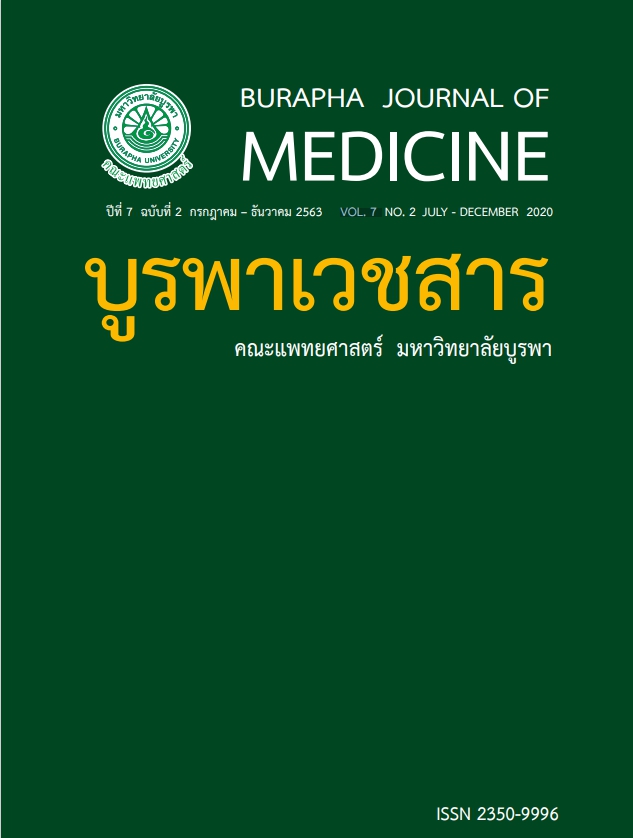ปัญหาสุขภาพและผลลัพธ์ของการรักษา ผู้ป่วยสูงอายุในหออภิบาลผู้ป่วยวิกฤตใน ประเทศที่มีรายได้น้อยและรายได้ปานกลาง: การทบทวนวรรณกรรมอย่างเป็นระบบและการวิเคราะห์อภิมาน
คำสำคัญ:
ผู้ป่วยสูงอายุ, ปัญหาสุขภาพ, ผลลัพธ์การรักษา, หออภิบาลผู้ป่วยวิกฤต, ประเทศที่มีรายได้น้อยและ รายได้ปานกลางบทคัดย่อ
ภูมิหลัง ผู้สูงอายุที่เข้ารับการรักษาในหออภิบาลผู้ป่วยวิกฤต (ไอซียู) มีอัตราตายสูง โดยเฉพาะในประเทศที่มี
รายได้น้อยและรายได้ปานกลาง (LMICs)
วัตถุประสงค์ การวิจัยโดยการทบทวนวรรณกรรมอย่างเป็นระบบและการวิเคราะห์อภิมานนี้มีวัตถุประสงค์
เพื่อสรุปสถานการณ์ปัจจุบันเกี่ยวกับปัญหาสุขภาพของผู้ป่วยสูงอายุที่เข้ารับการรักษาในไอซียูและผลลัพธ์ของ
การรักษาที่เกิดขึ้นในประเทศกลุ่ม LMICs
วิธีการศึกษา คณะผู้วิจัยทำการสืบค้นจาก 7 ฐานข้อมูล เพื่อค้นหาบทความวิจัยที่ศึกษาเกี่ยวกับลักษณะและการ
เจ็บป่วยของผู้ป่วยที่มีอายุ 60 ปีขึ้นไปที่เข้ารับการรักษาในไอซียูและผลลัพธ์ของการรักษาที่เกิดขึ้นในประเทศ
กลุ่ม LMICs ครอบคลุมการวิจัยโดยการสังเกตทุกรูปแบบที่ตีพิมพ์ระหว่าง พ.ศ. 2553-2562 โดยใช้เกณฑ์การ
ประเมินคุณภาพในการทบทวนวรรณกรรมอย่างเป็นระบบและการวิเคราะห์อภิมานตามข้อกำหนดของ PRISMA
และแบบตรวจสอบรายการของ Joanna Briggs Institute (JBI)
ผลการศึกษา บทความวิจัยจำนวน 10 บทความ จาก 1,486 บทความจากทุกแหล่งที่เข้าเกณฑ์การคัดเข้า
ครอบคลุมผู้สูงอายุ 4,915 คน ที่เข้ารับการรักษาในไอซียูทั่วไป 6 แห่ง และเฉพาะทาง 13 แห่งจาก 7 ประเทศ
ในกลุ่ม LMICs คุณภาพของบทความที่ได้ทบทวนโดยรวมอยู่ในเกณฑ์ปานกลาง ผลการวิจัยพบว่าอัตราตายของ
ผู้ป่วยหนักสูงอายุในหอผู้ป่วยวิกฤตและในโรงพยาบาลรวมเฉลี่ยอยู่ที่ 15.6% (95% CI = 14.1-17.2, p = 0.04,I2 = 96.9%) และ 33.3% (95% CI = 22.5-43.9, p<0.001, I2= 46.6%) มีระยะเวลาครองเตียง (LOS) ใน
ไอซียูและในโรงพยาบาลเฉลี่ย (S.D.) = 6.7 (10.6) และ18.8 (8.6) วัน โดยมากกว่าหนึ่งในสี่ของผู้ป่วยมีอาการ
รุนแรงและช่วยเหลือตนเองไม่ได้ตั้งแต่แรกรับ การติดเชื้อและปัญหาที่เกี่ยวข้องมักพบในระหว่างที่ผู้ป่วยรับ
การรักษาอยู่ในไอซียู
สรุปผลการศึกษา ผู้ป่วยหนักสูงอายุในประเทศกลุ่ม LMICs มักมีอาการรุนแรงตั้งแต่แรกรับและมีอัตราตายใน
หออภิบาลผู้ป่วยวิกฤติมากกว่าร้อยละสิบ ผู้ป่วยที่มีภาวะไตวายเฉียบพลัน มีภาวะสับสน ขาดสารอาหาร มีโรค
ร่วมและ/หรือติดเชื้อในกระแสโลหิตเป็นปัจจัยเสี่ยงของการตายและผลลัพธ์การรักษาที่ไม่พึงประสงค์อย่างมีนัย
สำคัญ
เอกสารอ้างอิง
health 2018 [Available from: https://www.
who.int/news-room/fact-sheets/detail/
ageing-and-health.]
2. United Nations, Department of Economics
and Social Affairs, Population Division.
World population ageing, 2017 highlights.
2017.
3. Brandberg C, Blomqvist H, Jirwe M. What is
the importance of age on treatment of the
elderly in the intensive care unit?: Elderly
patients in the ICU. Acta Anaesthesiol
Scand. 2013; 57: 698–703.
4. Murthy S, Leligdowicz A, Adhikari NKJ.
Intensive care unit capacity in low-income
countries: A systematic review. PLOS ONE.
2015; 10: e0116949.
5. Fuchs L, Chronaki CE, Park S, et al. ICU
admission characteristics and mortality
rates among elderly and very elderly
patients. Intensive Care Med. 2012; 38:
1654–61.
6. Fuchs L, Novack V, McLennan S, et
al. Trends in severity of illness on ICU
admission and mortality among the
Elderly. PLoS ONE. 2014; 9: e93234.
7. Kaarlola A, Tallgren M, Pettilä V. Longterm survival, quality of life, and qualityadjusted life-years among critically ill
elderly patients: Crit Care Med. 2006; 34:
2120–6.
8. Bagshaw SM, Webb SAR, Delaney A, et al.
Very old patients admitted to intensive
care in Australia and New Zealand: a multicentre cohort analysis. Crit Care Lond Engl.
2009; 13: R45–R45.
9. Siriwardhana DD, Hardoon S, Rait G, et al.
Prevalence of frailty and prefrailty among
community-dwelling older adults in lowincome and middle-income countries: a
systematic review and meta-analysis. BMJ
Open. 2018; 8: e018195.
10. Angus DC. Admitting Elderly Patients to
the Intensive Care Unit—Is it the Right
Decision? JAM. A2017; 318: 1443–4.
11. Vincent J-L, Marshall JC, Ñamendys-Silva
SA, et al. Assessment of the worldwide
burden of critical illness: the Intensive Care
Over Nations (ICON) audit. Lancet Respir
Med. 2014; 2: 380–6.
12. Moher D, Liberati A, Tetzlaff J, et al.
Preferred reporting items for systematic
reviews and meta-analyses: The PRISMA
Statement. PLoS Med. 2009; 6: e1000097.
13. World Bank Country and Lending Groups –
World Bank Data Help Desk 2020 [ Available
from: https://datahelpdesk.worldbank.org/
knowledgebase/articles/906519-worldbank-country-and-lending-groups.]
14. JBI. Joanna Briggs Institute 2017 Critical
Appraisal Checklist for Case Control
Studies. 2017; 6.
15. JBI. Joanna Briggs Institute 2017 Critical
Appraisal Checklist for Cohort Studies.
2017; 7.
16. Wan X, Wang W, Liu J, et al. Estimating
the sample mean and standard deviation
from the sample size, median, range
and/or interquartile range. BMC Med Res
Methodol. 2014; 14: 135.
17. Lankoandé M, Bonkoungou P, Simporé
A, et al. Inhospital outcome of elderly
patients in an intensive care unit in a SubSaharan hospital. BMC Anesthesiol. 2018;
18: 118.
18. Jayalakshmi S, Ruikar D, SudhindraVooturi,
et al. Determinants and predictors of
outcome in super refractory status
epilepticus—A developing country
perspective. Epilepsy Res. 2014; 108:
1609–17.
19. Sharma A, Malhotra S, Grover S, et al.
Incidence, prevalence, risk factor and
outcome of delirium in intensive care unit:
a study from India. Gen Hosp Psychiatry.
2012; 34: 639–46.
20. Sodhi K, Singla, MK, Shrivastava, A, et al. Do
Intensive Care Unit treatment modalities
predict mortality in geriatric patients:
An observational study from an Indian
Intensive Care Unit. Indian J Crit Care Med.
2014; 18: 789–95.
21. Poluyi Eo, Oo F, Co P, et al. Profile
of intensive care unit admissions and
outcomes in a tertiary care center of a
developing country in West Africa: A 5 Year
Analysis. J Intensive Crit Care. 02.
22. Giannasi SE, Venuti MS, Midley AD, et al.
Mortality risk factors in elderly patients
in intensive care without limitation of
therapeutic effort. Med Intensiva Engl Ed.
2018; 42: 482–9.
23. Shpata V, Ohri I, Nurka T, et al. The
prevalence and consequences of
malnutrition risk in elderly Albanian
intensive care unit patients. Clin Interv
Aging. 2015; 10: 481–6.
24. Yokota LG, Sampaio BM, Rocha E, et al.
Acute kidney injury in elderly intensive care
patients from a developing country: clinical
features and outcome. Int J Nephrol Renov
Dis. 2017; Volume 10: 27–33.
25. Limpawattana P, Panitchote A,
Tangvoraphonkchai K, et al. Delirium
in critical care: a study of incidence,
prevalence, and associated factors in the
tertiary care hospital of older Thai adults.
Aging Ment Health. 2016; 20: 74–80.
26. Trongtrakul K, Poopipatpab S, Pisitsak C, et
al. Acute Kidney Injury in Elderly Patients
in Thai-Surgical Intensive Care Units (THAISICU) Study. J Med Assoc Thail. 2016; 99
Suppl 6: S209–S218.
27. Jones AE, Trzeciak S, Kline JA. The
Sequential Organ Failure Assessment
score for predicting outcome in patients
with severe sepsis and evidence of
hypoperfusion at the time of emergency
department presentation. Crit Care Med.
2009; 37: 1649–1654.
28. Sousa ÁFL de, Queiroz AAFLN. LB de, et
al. Deaths among the elderly with ICU
infections. Rev Bras Enferm. 2017; 70:
733–9.
29. Neyeloff JL, Fuchs SC, Moreira LB. Metaanalyses and Forest plots using a microsoft
excel spreadsheet: step-by-step guide
focusing on descriptive data analysis. BMC
Res Notes. 2012; 5: 52.
30. Review Manager (RevMan) [Computer
program]. Version 5.3. Copenhagen: The
Nordic Cochrane Centre, The Cochrane
Collaboration. 2014.
31. Lin W-C, Chen C-W, Wang J-D, et al.
Is tracheostomy a better choice than
translaryngeal intubation for critically ill
patients requiring mechanical ventilation
for more than 14 days? A comparison of
short-term outcomes. BMC Anesthesiol. 15.
32. Bellelli G, Mazzone A, Morandi A, et al. The
effect of an impaired arousal on short- and
long-term mortality of elderly patients
admitted to an acute geriatric unit. J Am
Med Dir Assoc. 2016; 17: 214–9.



